I can't tell you much about this picture, other than it's an example of exquisite timing.
Wednesday, April 30, 2014
Friday, April 25, 2014
Wednesday, April 23, 2014
Tar Sands Oil Wins Over Whales
Despite scientific evidence on the issue being mixed at best, yesterday the Canadian government under Prime Minister Stephen Harper moved to remove humpback whales from its list of threatened species. Humpbacks will instead be classified as a "species of special concern." The end result of this decision by the Harper Government, well-known for its anti-science bias, is that the government is no longer required to protect habitat for the humpbacks. The endangered species legislation declares that “no person shall destroy any part of the critical habitat of any … listed threatened species”, however such legislated protections are denied to species listed as a "special concern" and the Harper Government is no longer obligated to protect humpback habitat. The fact that the Harper Government, in its zeal to turn Canada into a third-rate petro-state, is pulling out all the stops to promote the Northern Gateway pipeline project which will result in increased oil tanker traffic and an increase in the risk of oil spills in humpback habitat on the west coast is, I'm sure, simply an astonishing coincidence. The government acknowledges in a statement that the downgrade "could result in small benefits to industry in the form of cost savings." Happy Earth Day from the Harper Government.
Needless to say, reaction has been swift and fairly negative. Even the generally conservative Globe and Mail issued a less-than-supportive editorial (and if you're a pro-business government and you've lost the support of the Globe, that's saying smething). One environmentalist echoed many of the sentiments of his peers (as related by the Vancouver Sun):
Needless to say, reaction has been swift and fairly negative. Even the generally conservative Globe and Mail issued a less-than-supportive editorial (and if you're a pro-business government and you've lost the support of the Globe, that's saying smething). One environmentalist echoed many of the sentiments of his peers (as related by the Vancouver Sun):
“There are outstanding questions about the scientific reliability and sufficiency of the information (the committee) used to make the determination to down-list humpback whales,” said Chris Genovali, executive director of Raincoast Conservation Foundation.Check out the graphic below from the Globe and Mail, and tell me it's not about oil profits over everything else as you consider the closing words of the Globe's editorial:
“The proposed change in status for humpback whales would place them in jeopardy, particularly given the impending threats” posed by Northern Gateway and the proposed Kinder Morgan pipeline expansion to Burnaby, would increase the number of arriving tankers from eight to 28 per month.
When it comes to weighing the environmental impact of the proposed Northern Gateway pipeline, the government should err on the side of caution. In the case of the humpback whale, it is not even coming close to giving the impression of doing so.
Tuesday, April 22, 2014
Portugal to Florida by Kayak
Polish adventurer Aleksander “Olek” Doba completed his amazing 6,000 mile solo kayak voyage from Portugal to Florida over the weekend. Battling winds and mechanical troubles, the 67 year-old Doba completed the continent-to-continent crossing in 195 days.
Thursday, April 17, 2014
Yowza, Indeed
Randy Braun was out paddling in his kayak when he sensed something was in the water near him. Fortunately for the rest of us, he had a drone-mounted GoPro camera with him. As he said on his Facebook page, "I had a hunch something was near me, and so without hesitation or "compass dance" I tossed mine straight up from my kayak. Yowza!"
Check out some of his other photos here.

Check out some of his other photos here.

Old School Kayak Racing
Here's a great clip from British Pathé showing a 1955 kayaking event. It takes place at the Marsh Lock, Henley-on-Thames, Oxfordshire, England. Talk about old school. My, how equipment has changed. I love the inflatable life jackets. Check out the embed below:
Wednesday, April 16, 2014
Kayaking In Greenland
Here's a gorgeous little video I stumbled upon of kayaking in Greenland. Check out the embedded video below:
Tuesday, April 15, 2014
Selkie legends and kayaks
The stories of Inuit kayakers being found in northern Scotland are fascinating. Certainly there were in Norse countries some samples of Inuit kayaks and people brought to Europe by Vikings (here's a link to a discussion of this idea)-- and I wonder just how many people made their own way from Greenland to Iceland or northern Europe...
The stories of selkies fascinate me too. These legendary skin-changers are humans on land, and when they put on their seal skins, they are seals at sea. We have a blog post about Sula Sgeir, home of a selkie in a folksong.
Now I've found a wonderful website on the heritage of the Orkney Islands, which has an interesting page connecting those two fascinating stories. And now I'm off to paddle my own kayak.
The stories of selkies fascinate me too. These legendary skin-changers are humans on land, and when they put on their seal skins, they are seals at sea. We have a blog post about Sula Sgeir, home of a selkie in a folksong.
Now I've found a wonderful website on the heritage of the Orkney Islands, which has an interesting page connecting those two fascinating stories. And now I'm off to paddle my own kayak.
Monday, April 14, 2014
Thetis Lake

This morning, Louise and I headed down to Thetis Lake so that Louise could try a dry-suit for the first time. Up to this time, Louise has used various combinations of neoprene pieces and paddling jackets. However, her main paddling jacket is in need of replacement and we've been discussing the pros and cons of a dry-suit as a replacement. Personally, I don't see any cons to a dry-suit -- except maybe the cost -- but until now Louise has remained unconvinced. We borrowed a dry-suit from another local paddler, but when she put it on we quickly discovered that Louise suffers from "clothestropohbia" -- a fear of confined clothing.
Our plan today was to paddle around the lake, then play in the water a bit so that Louise could get an idea of what a dry-suit is like.
We were about to hit the water when we suddenly realized that in our concern over getting the dry-suit ready for Louise, we'd forgotten out PFDs! Whoops!
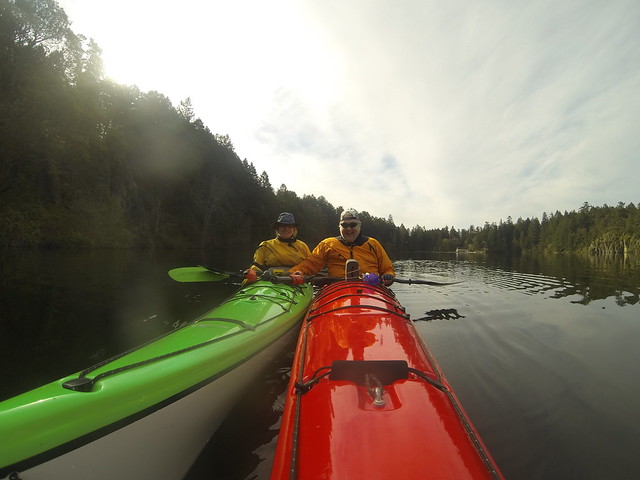
What to do? If we were launching into the ocean without out PFDs, well, we wouldn't. But this being a lake we decided that sticking close to the shore should be safe enough. Thetis Lake is actually a deceptively deep lake; many a poor swimmer has encountered serious, in some cases fatal, trouble by walking out into the water from shore not realizing that the bottom drops off sharply and unexpectedly.
So, carefully, off we went.
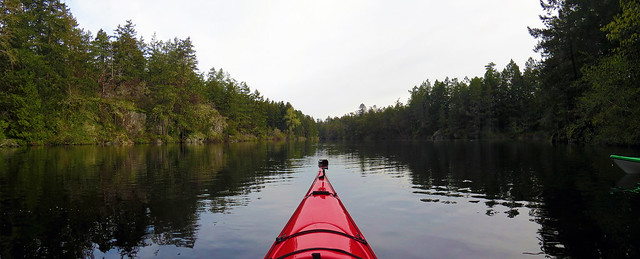
Soon we found some trash floating near the main beach.
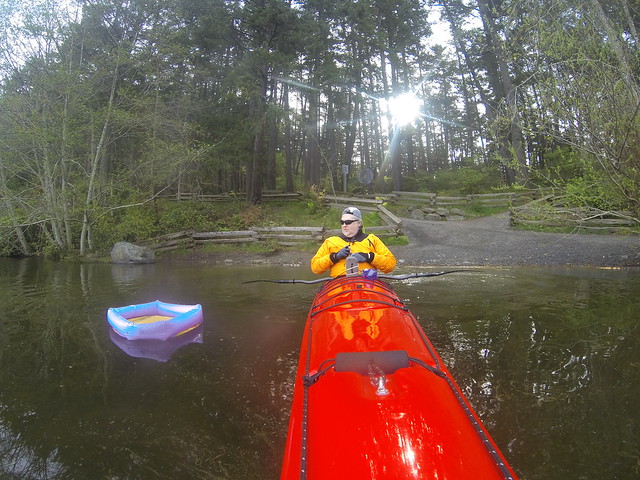
I'm not sure what it is -- a floating drink tray? Summer is starting early in the park! We put it ashore near a garbage can.
We continued on.

Among the trees and bushes along the shore I thought I saw a giant turtle. All I saw was a round shiny back, so my first thought was turtle, since we know there are turtles in the park. Then I saw it again, and it was definitely not a turtle. Too fast for one thing. Moving between the trees, it waddled along. Otter, maybe? We have seen those here, too.
But then I noticed the tree it walked by.
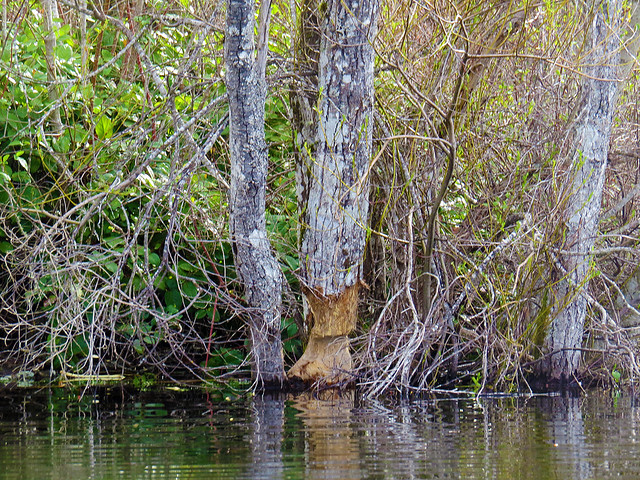
I'm pretty sure that otters don't eat trees.
So, a beaver then? Maybe, especially because Louise pointed out the large beaver mound behind the tree.
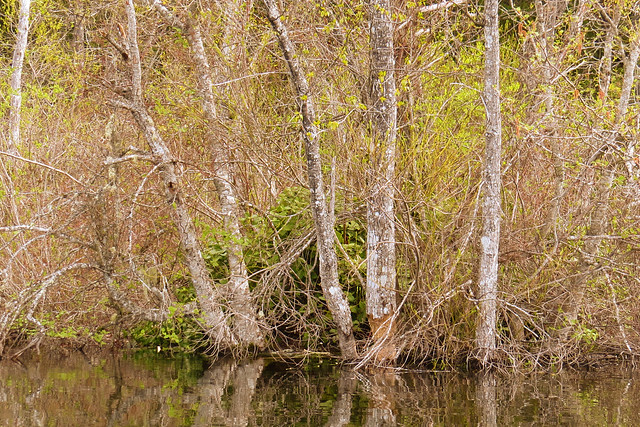
We moved into an arm of the lake that we know has turtles in it...
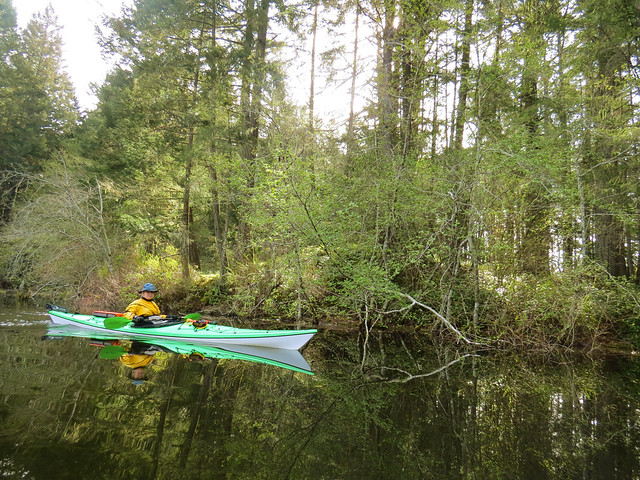
...and sure enough, there were two.
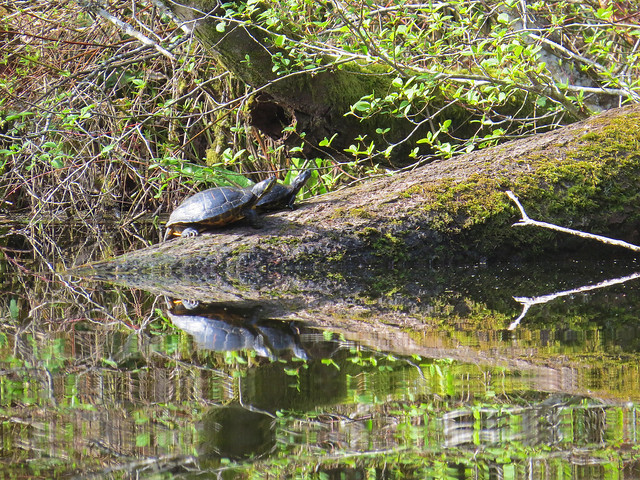
Soon it was time to head back. Louise has promised to report on her dry-suit experience.

Trip length: 6.04 km
YTD: 18.75 km
More pictures are here.

Thursday, April 10, 2014
Canoe Jousting!
Because alcohol and testosterone aren't dangerous enough when combined.
Check out the embedded video below:
"But wait!" you say, "what about jousting in kayaks?"
Don't worry, the two videos below have that covered.
Check out the embedded video below:
"But wait!" you say, "what about jousting in kayaks?"
Don't worry, the two videos below have that covered.
Ecological Reserves
Are you not only a paddler, but also a friend of an ecological reserve? It's nice to think of ourselves as friends to these protected places, based on our blog posts about some of 'em!
There's a great website that lists all the ecological reserves here in British Columbia. Many of these reserves are on lakes and islands; just looking at this list makes me want to take my little inflatable kayak out to paddle as many of these places as possible! As possible without treading on bird's nests or fragile plants, of course.
There's a great website that lists all the ecological reserves here in British Columbia. Many of these reserves are on lakes and islands; just looking at this list makes me want to take my little inflatable kayak out to paddle as many of these places as possible! As possible without treading on bird's nests or fragile plants, of course.
Wednesday, April 09, 2014
There Goes Dinner
Last week, a fisherman in Florida on a sit-on-top kayak lost his dinner when a bull shark made off with most of the grouper he was about to land. At least the shark left enough for fish head soup. Check out the embedded video below; the real action starts at about 1:20.
Tuesday, April 08, 2014
Be Seen
Here's a not-so-gentle reminder that just because you can see a boat coming towards you doesn't mean that the people on the boat can see you. Especially at night.
A boater in New Zealand was the last of nine boats in a row crossing a channel in the late evening. He told local media, “I was following another boat on the same heading, but a little out to his left so I could ride the smooth water in his wake about fifty metres off his stern. I felt the boat collide with an object and run up over something. I shut down the throttle and engaged neutral and turned hard to starboard pulling up fairly quickly.”
The boater turned his floodlight, and saw that he had indeed struck a kayaker, who was now floundering in the water. Fortunately, the kayaker bailed out of his kayak just before impact. But as he tried to ascertain the condition of the swimming kayaker, a second kayak and then a third paddled out of the darkness. Luckily, neither the kayaker nor his kayak were injured, but now the group faced a different problem. The boater continues, “It was clear he had no idea how to re-enter his kayak so I directed the other two kayakers to right his kayak and get him out of the water.” The boater, as it turned out, is an experienced kayaker and was able to instruct the group how to get their mate back in his kayak.
None of the three kayaks had any lights, and despite the fact there were three people on the boat facing forwards and keeping lookout, none of them saw the kayak until they collided.
So remember, be seen! Lights, reflective clothing and equipment. You don't want to end up being some boater's speedbump.
A boater in New Zealand was the last of nine boats in a row crossing a channel in the late evening. He told local media, “I was following another boat on the same heading, but a little out to his left so I could ride the smooth water in his wake about fifty metres off his stern. I felt the boat collide with an object and run up over something. I shut down the throttle and engaged neutral and turned hard to starboard pulling up fairly quickly.”
The boater turned his floodlight, and saw that he had indeed struck a kayaker, who was now floundering in the water. Fortunately, the kayaker bailed out of his kayak just before impact. But as he tried to ascertain the condition of the swimming kayaker, a second kayak and then a third paddled out of the darkness. Luckily, neither the kayaker nor his kayak were injured, but now the group faced a different problem. The boater continues, “It was clear he had no idea how to re-enter his kayak so I directed the other two kayakers to right his kayak and get him out of the water.” The boater, as it turned out, is an experienced kayaker and was able to instruct the group how to get their mate back in his kayak.
None of the three kayaks had any lights, and despite the fact there were three people on the boat facing forwards and keeping lookout, none of them saw the kayak until they collided.
So remember, be seen! Lights, reflective clothing and equipment. You don't want to end up being some boater's speedbump.
Monday, April 07, 2014
Friday, April 04, 2014
Riverbank Fandango
I've heard about canoe ballet, where the paddler dances the canoe over still water. John has some interesting video, and there's some writing online done by Becky Mason about her Classic Solo artistic canoe paddling. We've even written a little about dancing here on Kayak Yak... not much like what Becky Mason does, alas.
But there's some actual dancing being done in actual canoes by dancers and paddlers. Check out this video choreographed by Tanya Williams. It's called "Riverbank Fandango" -- presented by the Wellington Water Watchers and the Two Rivers Festival in Guelph, Ontario, on June 15, 2012.
If you don't see the video here, you can look on Tanya's own website, or see it at the website of one of her colleagues, Sarah Tolmie.
But there's some actual dancing being done in actual canoes by dancers and paddlers. Check out this video choreographed by Tanya Williams. It's called "Riverbank Fandango" -- presented by the Wellington Water Watchers and the Two Rivers Festival in Guelph, Ontario, on June 15, 2012.
If you don't see the video here, you can look on Tanya's own website, or see it at the website of one of her colleagues, Sarah Tolmie.
Wednesday, April 02, 2014
What Not To Do When Encountering An Orca
While the video embedded below is spectacular footage of an orca, it is the exact wrong thing to do when encountering whales and orcas.
A fellow on an SUP encountered a baby orca off of Auckland, New Zealand and he quickly paddled towards it. He jumped into the water to get an underwater shot and that's when mommy orca came by and guided the youngster away.
How close is too close when you encounter whales?
 Fisheries and Environment Canada recommend that vessels (and that includes kayaks) should stay a minimum 100 metres away from whales. Don't approach from in front or behind, only from the sides.
Fisheries and Environment Canada recommend that vessels (and that includes kayaks) should stay a minimum 100 metres away from whales. Don't approach from in front or behind, only from the sides.
But what about New Zealand regs? They seem a little looser:
New Zealand regs actually don't offer a minimum safe distance for watercraft, only a 150m safe distance for aircraft. However, they do say that you should "manoeuvre your boat sensitively near dolphins. Do not obstruct their path, cut through a group or separate mothers from calves" which is exactly what this clownhead was doing. Paddling as hard as you can towards a baby orca? Oh yeah, that's harassment.
A fellow on an SUP encountered a baby orca off of Auckland, New Zealand and he quickly paddled towards it. He jumped into the water to get an underwater shot and that's when mommy orca came by and guided the youngster away.
How close is too close when you encounter whales?
 Fisheries and Environment Canada recommend that vessels (and that includes kayaks) should stay a minimum 100 metres away from whales. Don't approach from in front or behind, only from the sides.
Fisheries and Environment Canada recommend that vessels (and that includes kayaks) should stay a minimum 100 metres away from whales. Don't approach from in front or behind, only from the sides.But what about New Zealand regs? They seem a little looser:
When boating in the vicinity of killer whales, common sense rules apply and regulations exist so as disturbance and danger are minimised.
Orca are predators with quite a reputation, but no records exist of deliberate fatal attacks on humans. It still pays however, to show respect around these animals. General rules are outlined below:
- Operate your boat slowly and quietly at “no wake” speed
- Manoeuvre your boat sensitively near dolphins. Do not obstruct their path, cut through a group or separate mothers from calves
- Avoid sudden noises that could startle the animals
- Co-operate with others so all may see the dolphins without putting them at risk
Aircraft should also maintain a safe distance of at least 150 metres from killer whales and should not fly directly overhead.
New Zealand regs actually don't offer a minimum safe distance for watercraft, only a 150m safe distance for aircraft. However, they do say that you should "manoeuvre your boat sensitively near dolphins. Do not obstruct their path, cut through a group or separate mothers from calves" which is exactly what this clownhead was doing. Paddling as hard as you can towards a baby orca? Oh yeah, that's harassment.
Tuesday, April 01, 2014
Kayaks on the BART
A few years ago, we published a local news story here on the blog about BC Transit planning to put kayak racks on the front on their buses.
This year, The Berkleyside reports that a San Francisco transit service is doing BC Transit one better by allowing kayaks on the BART, the Bay Area Rapid Transit system in San Francisco. Of course, kayakers aren't going to have carte blanche on the BART. Some the rules kayakers will have had to follow include:
This year, The Berkleyside reports that a San Francisco transit service is doing BC Transit one better by allowing kayaks on the BART, the Bay Area Rapid Transit system in San Francisco. Of course, kayakers aren't going to have carte blanche on the BART. Some the rules kayakers will have had to follow include:
-- Kayakers must yield priority seating to seniors and people with disabilities, yield to other passengers, and not block aisles or doors or soil seats. Be particularly careful not to spill seawater or marine life on seats.These changes take effect today, April 1.
-- In case of an evacuation due to tunnel flooding, inform the train operator that you have a kayak on board. You may be asked to paddle for help.
Subscribe to:
Posts (Atom)

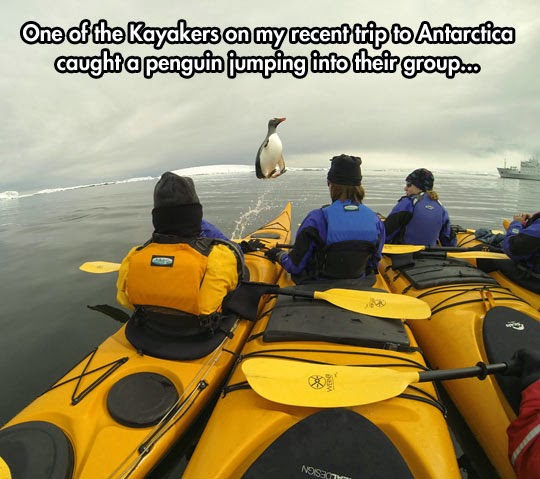


.jpg)


